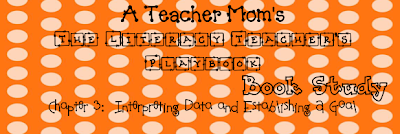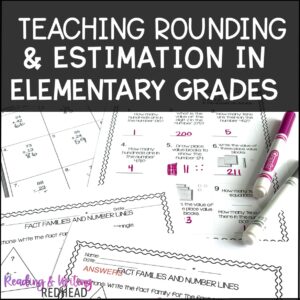
Hey all! Welcome back to the book study for The Literacy Teacher’s Playbook – week #4, run by Abbey of A Teacher Mom! This week we are looking at chapter 3 in Jennifer Serravello’s book The Literacy Teacher’s Playbook (I am reading the K-2 version but there is also a version for upper elementary- check them out below and click on the images to read more about them at Amazon).
In the first chapter of the book we read about data collection and chapter two provided very detailed information about analyzing data. This week, chapter three focuses on interpreting data and establishing goals. I really like Serravello breaks up data analysis into two parts- analyzing and then interpreting data while using it to create a goal. Analyzing and interpreting are two different things, even though I tend to get them mixed up. Analyze means to closely and carefully study something and to learn the characteristics and relationship of the parts of something by studying it. Interpret means to explain the meaning of something and/or to understand it in a specific way. So after we assess a student, we first will study the results so we can learn about the child’s performance and how they learn. To interpret the data and then set a goal, we need to be able to understand it in a way so that we can explain it, perhaps to ourselves, to the student, or to a team at a meeting. This might be the difference between analyzing an oral reading fluency score and saying “This student did not meet the benchmark. He is making a lot of errors and not self-correcting” and interpreting the data and other information we have about the student and saying, “His oral reading fluency score is below the benchmark. He made very few errors on sight words and CVC words, but words with vowel digraphs and consonant digraphs were frequently read wrong. He is concentrating on reading each word one at a time and is so focused on that he is not attending to the meaning of the text; therefore when he makes a mistake, he is not self-correcting because he does not know that it does not make sense in the context of the story”.
Serravello is all about digging deeper (my words) in this chapter. She gives us a lot of tools, ideas, and examples on how to interpret data and then use that data to set some goals. She emphasizes the importance of making sure you connect each goal to a strength which I think is a neat idea and when she is charting the tools she used for assessment and the student’s strengths she calls the “goal” column “possibilities for growth”.
Serravello also spends a great deal of time in this chapter going over in great detail how to run a goal setting conference. She tells you the pitfalls to avoid (for example, if you ask a student just to make a goal on the spot they might say something like “read more” or “read harder books”. She helps the reader get ready one step at a time to meet with their students by discussing what materials they should bring to the table when they meet with the student, how much time to set aside for the conference itself, and even possible scripts for the conference. I love how she always gives examples and she shares with us a goal setting conference she had with one of her students so we can see word for word what happened.
The one negative I have with this chapter is the time she suggests to allot to have a goal setting conference with a child. She says 5-10 minutes. Now 5-10 meetings to a salesperson or a CEO may seem like enough time for a quick meeting, BUT I am a classroom teacher and last year I had 22 students. If I had a 10 minute goal setting conference with every student, it would be 220 minutes of class time!!! There is a lot of pressure on us to get that curriculum taught! Plus I have to be doing reading groups 4 days a week for most of reading workshop, so I just do not know where I would find the time. I am intrigued by the idea though and wonder if I could try this year with just 2-3 students and see how it goes. Serravello also seems to describe situations where a specialists (such as maybe a reading teacher) comes into the classroom while the teacher is working with the rest of her class and does these conferences. That would be ideal!
What do you think? Do you interpret data thoroughly and use it to set goals for your students? Do you hold goal setting conferences?
Be sure to enter our rafflecopter this week and follow the linky below to see who else linked up! Thanks for stopping by and come back next week for part 1 of chapter 4!
Here are a few great resources for teaching literacy. Click on each image to learn more at Amazon.










